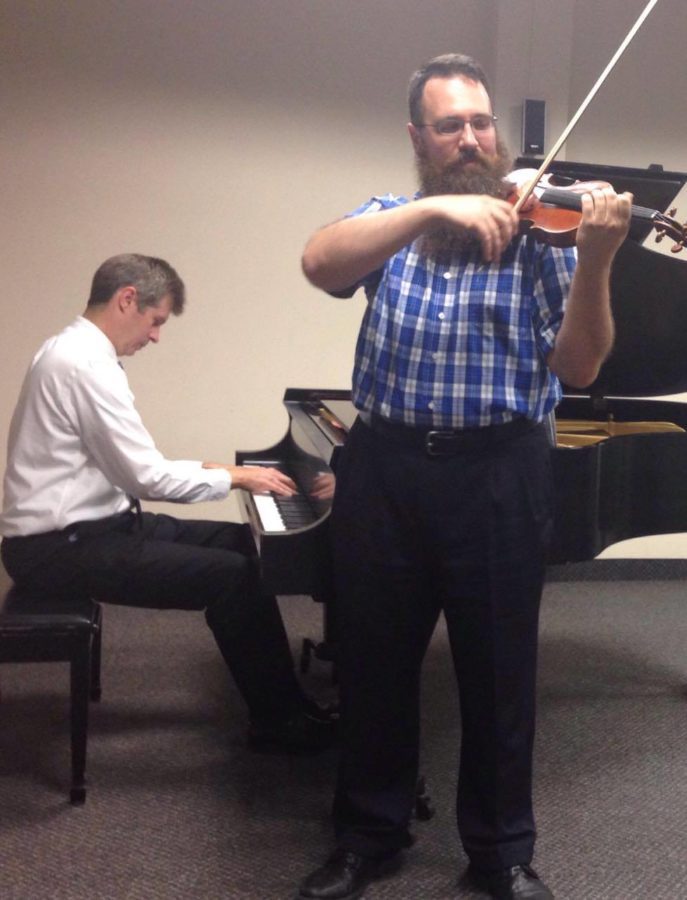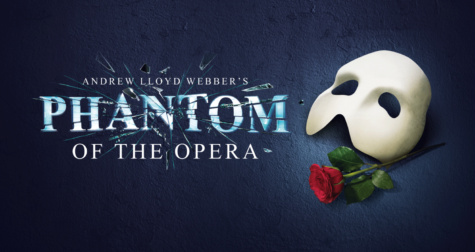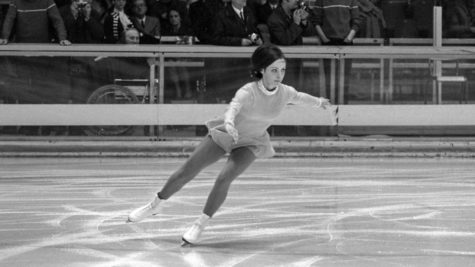Violin recital to be like a French soiree
Nathan Hess, D.M.A., left, and Jonathan Moser are two of the performers for the Faculty Collage concert. They will perform as a duet, and Hess will solo as well.
January 31, 2017
On Feb. 15, at 8p.m., Jonathan Moser, M.M., will be giving a recital in Walker Recital Hall accompanied by Nathan Hess, D.M.A., on piano.
Also featured in Moser’s recital are guest artists Rebecca Wunch on clarinet, Scott Meier, Ph.D., on saxophone and members of the Mercyhurst University Dance Department.
“The recital has a French theme,” said Moser. “It’s designed around two ensemble pieces.
“I knew I wanted to perform a work with saxophone, violin and piano … I found Marc Eychenne’s ‘Cantilene et Danse,’ which happened to be French.”
Eychenne (b. 1933), a Modernist composer from Algiers, composed “Cantilene et Danse” in 1961.
Eychenne began his music career as a respected violinist, but later in his career he also proved to be a successful composer of numerous works, including “Requiem” (1989).
“The other ensemble piece I chose, Milhaud’s Suite for violin, clarinet and piano Op. 157b was also French,” said Moser, “and allowed me the opportunity to work with Becky Wunch.”
“The recital is also the day after Valentine’s Day, which is perfect with the French theme.”
The 20th century French composer Darius Milhaud (1892-1974) was a prolific composer and a member of a group of six French composers working in Montparnasse known as Les Six.
Milhaud’s Suite for violin, clarinet & piano, Op. 157b was published in 1937.
“We open with the Milhaud,” said Moser. “The expression marking for the first movement is ‘vif et gaie’ (lively and happy).
“The suite is full of life. There’s a cool tango section at the end; it’s a very energetic piece to open with.”
Also featured on the program is the French composer Claude Debussy’s (1862-1918) Violin Sonata in G minor, L 140.
“Dr. Hess and I knew we wanted to play something of Debussy’s,” Moser said.
“This sonata is one of his last compositions.
It was written in 1917, during World War I, when he was at the end of his life and very depressed,” Moser said.
Despite his depression, the sonata has remarkable energy and lightness. It is also very turbulent.”
Moser will be playing another piece by a more obscure French composer, Lili Boulanger (1893-1918).
Boulanger, the younger sister of the better known composer and teacher Nadia Boulanger, died at the young age of 24, cutting short what had already begun to be a promising career in composition.
She composed many works before her untimely death, one of which is her “Nocturne for violin and piano,” which Moser has chosen to interpret on his recital. “It’s a beautiful work,” Moser said.
Moser has included on the program a solo piece, a work for solo violin by the Belgian composer Eugène Ysaÿe (1858-1931).
“Ysaÿe was a violinist, the best of the 20th century,” said Moser.
“He wrote six sonatas for violin in homage to Bach’s six sonatas for solo violin. Each of Ysaÿe’s violin sonatas are a tour de force, but I’ve chosen to perform Sonata No. 3 in D minor, ‘Ballade.’
It’s the shortest sonata, but it explores technical aspects of the instrument while maintaining lyricism.”
The recital will close with an exciting work by the French Impressionist composer Maurice Ravel (1875-1937), “Tzigane.”
First performed in London in 1924, “Tzigane” (a French word for gypsy, particularly a Hungarian gypsy), was inspired by and composed for the female virtuoso Hungarian violinist Jelly d’Arányi.
“It’s a lively, rhapsodic piece,” Moser said. This piece will also feature members from the Mercyhurst Dance Department with original choreography from Solveig Santillano, associate professor of dance.
“I have a passion for collaborations, and was thrilled to be able to carpe that diem.
“Mark and I are choreographing to the piece (Ravel) on six beautiful dancers who will perform the finished work with Moser in the Walker.” Santillano said.
In March they will use the same group to perform the piece at an adjudicated performance at the American College Dance Association conference in Maryland.
They are still in the creation process.
“We are exploring issues surrounding women and community.
“We have a central Baba Yaga, or wise-woman figure, and are working with an array of images relating to silence, defiance, manipulation and literally climbing on the backs of others,” Santillano said.
When asked why the public might enjoy his recital, Moser replied, “Well, it’s so full of excitement, of fire, and variety. There’s not much downtime.”











